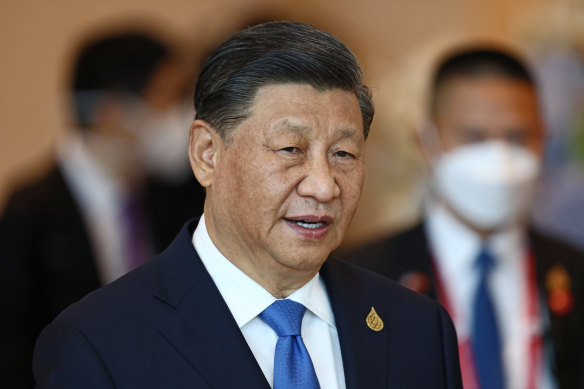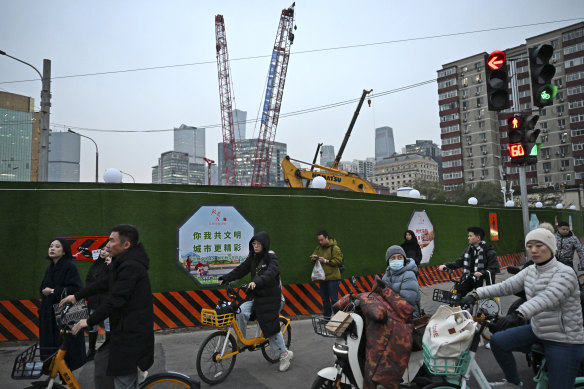This was published 4 months ago
Opinion
Xi Jinping will be desperate not to repeat his mistake from a decade ago
Stephen Bartholomeusz
Senior business columnistIn the middle of this month, China’s Communist Party leaders, military leaders, provincial heads and academics will gather to map out the country’s long term economic strategies. Expectations for major changes are low.
The “third plenum”, one of seven meetings held between the party’s five-yearly Congresses (the other six are mainly concerned with personnel and internal party issues), will outline the party leadership’s economic plans and goals for the next decade.

Xi Jinping is desperate to stimulate China’s stuttering economy.Credit: AP
Previous third plenums have resulted in massive reforms.
In 1978, Deng Xiaoping set in train the transformation of China’s economy by opening it to the world while, in 1993, Jiang Zemin laid the foundations for a more market-oriented economy, with the plenum deciding that the market would take the decisive role in allocating resources and that state-owned companies would be allowed to go bankrupt.
While it is likely that the coming plenum will produce plans to tackle some of the challenges confronting the economy, it is improbable that there will be major changes of direction given that, for the past decade, Xi Jinping has directed China’s economic policies.
The gathering is being held far later than normal, given that the third plenum is usually convened a year after the party’s five-yearly congress and was therefore expected to occur in October or November last year. No explanation has been given for the delay, although the number and complexity of the challenges China faces might have something to do with it.
The party’s leadership in the politburo provided a hint of the meeting’s agenda late last month, saying it would seek endorsement of a “resolution on comprehensively deepening reform and advancing Chinese modernisation”.
Xi has been outlining his own vision for the economy in speeches where he has focused on (and devoted massive amounts of government funding) to what he has called “high quality” development, or technologies like semiconductors, artificial intelligence, robots, advanced manufacturing, big data and “green technologies” considered as the key to geo-economic leadership over the next several decades at least.
These new quality productive forces, as he has described them, involve “advanced productivity freed from traditional economic growth models”.
It is expected there will also be a whole-of-state effort, directed by Beijing, to both respond to “bottleneck technologies” such as advanced computer chips, where the West, and the US in particular, have significant leads over China, while leapfrogging the US and dominating other key emerging technologies.

The plenum might do more to help restore activity to China’s property sector, to rebuild consumer confidence and spending.Credit: Getty Images
China is confronting a number of problems the plenum will also have to address.
Xi’s crackdown on property developers and the big technology companies in 2021 dealt massive blows to China’s private sector and to its consumers.
The property sector plunged into a downward spiral, with developers collapsing and sales and prices falling continuously, although very recently there have been some tentative signs that a range of government policies to try to stabilise the sector might be having some effect.
The listed private technology sector had around $3 trillion wiped off its market capitalisation as a result of the crackdown.
As a result of the actions against the property and tech companies, where private companies represented about 55 per cent of the value all Chinese listed entities in 2021, they represented only about 35 per cent at the end of last year.
That’s reflective of the broader trends within the economy.
Private enterprises, which had generated a disproportionate share of China’s growth – a decade ago they generated about 60 per cent of the growth – now provide less than half, after Beijing poured resources into state-owned or controlled enterprises in pursuit of fused economic and military industry strategies. The party has tightened its control over private businesses.
While China has said it now wants to treat private entities equally with state-owned entities, the private sector’s confidence and willingness to invest has been undermined by the events of the past three years.
So too has the confidence of foreign investors, despite a concerted attempt by China’s leadership to drum up foreign investment. Last year, for the first time in a decade, there was a net outflow of foreign investment.
China’s deteriorating trade relationships with its biggest market in the West – the US and Europe – aren’t helping and represent a threat to Xi’s strategies.
China’s emphasis on an expansion of manufacturing and exports to offset weak domestic demand has run into tariff walls in the US and, it appears probable, Europe because of the threat of excess capacity in Chinese factories to their domestic industries.
The US and its allies are also restricting China’s access to some of the building blocks of advanced technologies, like the newest generations of semiconductors and the machinery to make them.
Domestic consumption, perhaps because of the wealth shock created by the implosion of the property sector, has remained weak and, so far, Beijing’s efforts to stimulate it have been modest.
China is confronting a number of problems that the plenum will have to address.
The property sector woes have also exposed vertical fiscal imbalances within the economy. Beijing raises most of the revenue while local governments do most of the spending.
That has made local governments reliant on land sales and high levels of off-balance-sheet funding to fund their operations, with the deep downturn in property leaving many local governments at financial breaking point.
The plenum will inevitably have to do something to reform that mismatched relationship between revenue and expenditures and bail out the most affected local governments. It might also do more to help restore activity to the property sector, a prerequisite for rebuilding consumer confidence and spending.
It is unlikely that anything particularly bold will be announced at the plenum. Xi’s shift from the previous prioritisation of growth towards national security and geopolitical dominance won’t be undone.
It is also unlikely the plenum will provide much detail on its plans for challenging the US in the advanced technologies that will determine future geo-economic and geopolitical leadership.
It was Xi’s detailed “Made in China 2025” plan released a decade ago that first alerted the rest of the world to his economic ambition of government-driven and incentivised domination of key 21st century technologies, and through that dominance, geopolitical leadership.
That ignited the backlash to the export drive towards that dominance that has prompted barriers to China’s trade rising steadily in the West. It is improbable that he will make the same mistake.
The Business Briefing newsletter delivers major stories, exclusive coverage and expert opinion. Sign up to get it every weekday morning.